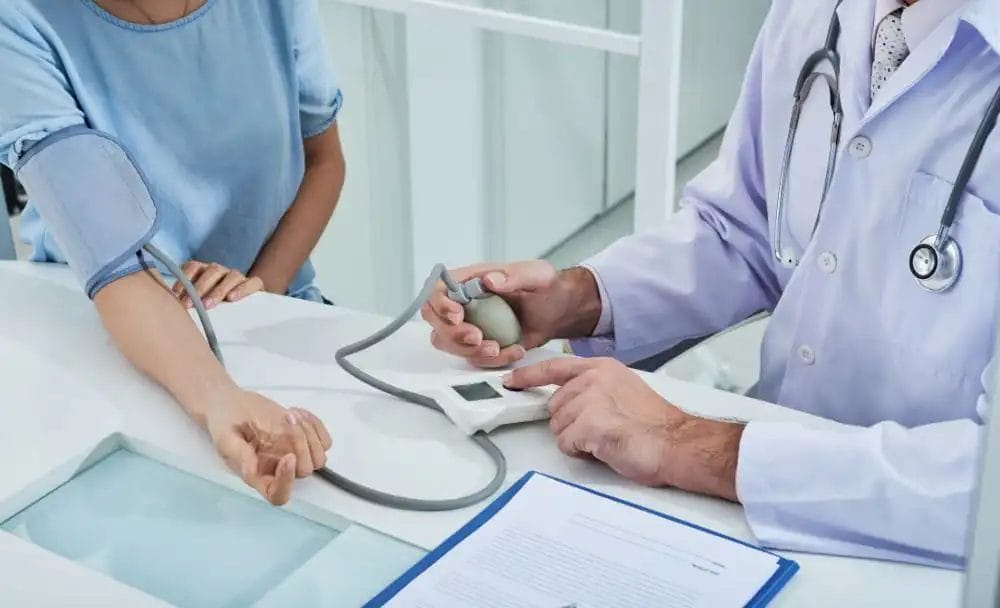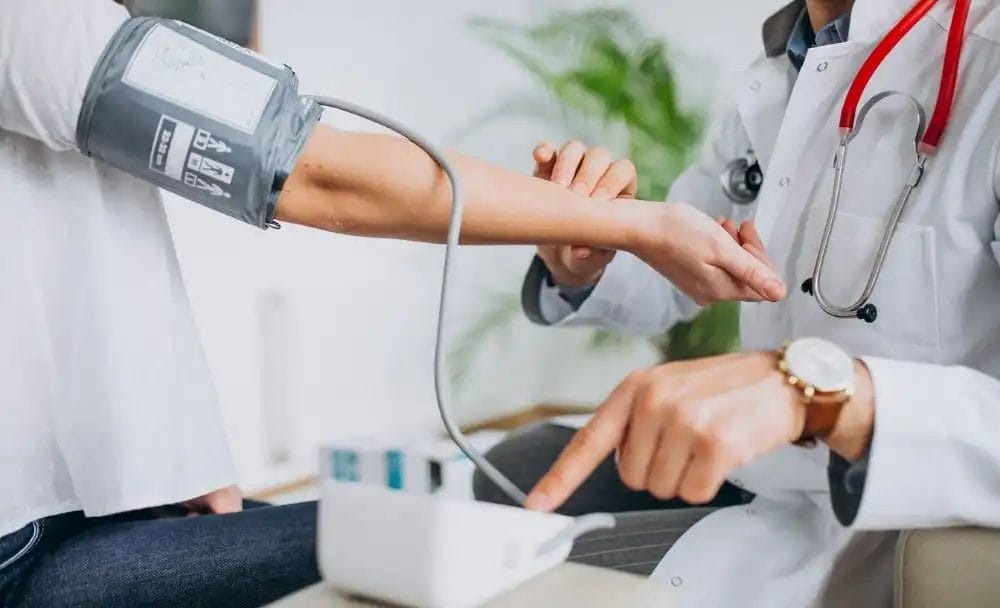This article is reviewed by Livayur’s Team of Experts

Hypotension, also known as low blood pressure, refers to a condition in which the force of blood against the walls of the arteries is lower than normal. While there isn’t a universally agreed-upon hypotension range or threshold for low blood pressure, it’s generally considered to be a systolic blood pressure (the top number) below 90 mm Hg or a diastolic blood pressure (the bottom number) below 60 mm Hg 1.
Hypotension Symptoms: Recognizing The Warning Signs 1
- Dizziness or Lightheadedness: Feeling unsteady, as if you might faint.
- Blurred Vision: Visual disturbances or tunnel vision.
- Fatigue: Feeling unusually tired or weak.
- Nausea: Feeling queasy or nauseated.
- Rapid Heartbeat (Tachycardia): Heart rate increases to compensate for low blood pressure.
- Confusion: Cognitive changes or difficulty concentrating.
- Cold, Clammy Skin: Skin feels cold and may be accompanied by sweating.
- Pale Skin: Skin color may appear paler than usual.
- Fainting (Syncope): A brief loss of consciousness due to insufficient blood flow to the brain.
Severe hypotension can lead to shock, a medical emergency characterized by insufficient blood flow to vital organs. Symptoms of shock include rapid and weak pulse, rapid and shallow breathing, confusion, bluish lips or nails, and unconsciousness. Shock requires immediate medical attention and should be treated as a medical emergency.
It’s important to note that some individuals may have naturally lower blood pressure without experiencing hypotension symptoms. However, if you experience persistent or severe symptoms, especially if accompanied by signs of shock, seek medical help promptly. Chronic hypotension may be due to underlying medical conditions such as heart problems, hormonal imbalances, or dehydration, and should be evaluated and managed by a healthcare professional.
Hypotension Causes & Risk Factors
Hypotension (low blood pressure) can be caused by various factors, and its underlying causes are often related to how the body regulates blood pressure. Common hypotension causes include 2:
- Dehydration: Inadequate fluid intake can lead to reduced blood volume and lower blood pressure.
- Medications: Certain medications, like antihypertensives, diuretics, and some antidepressants, can cause low blood pressure as a side effect.
- Heart Conditions: Heart problems such as heart valve issues, heart attack, or heart failure can result in decreased cardiac output and hypotension.
- Endocrine Disorders: Hormonal conditions like Addison’s disease and thyroid dysfunction can affect blood pressure regulation.
- Neurally Mediated Hypotension: This is a condition where blood pressure drops after standing up due to a sudden miscommunication between the heart and the brain.
Hypotension Risk Factors 3:
- Age (older adults are more prone)
- Certain medical conditions (e.g., diabetes, Parkinson’s disease)
- Medication use
- Family history of low blood pressure
- Prolonged bed rest or immobility
- Pregnancy
Hypotension Treatment
Proven treatments for hypotension (low blood pressure) depend on the underlying cause and severity of the condition. Here are various hypotension treatment options, including conventional and alternative therapies:
Medical Treatments:
- Fluids: For mild cases due to dehydration, increasing fluid intake can help raise blood volume and blood pressure.
- Medications: In some cases, doctors may prescribe medications such as fludrocortisone or midodrine to manage hypotension 4. They help retain sodium and fluids or constrict blood vessels respectively.
- Compression Stockings: These garments help improve blood circulation and prevent blood pooling in the legs, protecting against associated complications 5.

Ayurvedic Treatments [9]:
Ayurvedic herbs and therapies have been used traditionally to support various health conditions, including blood pressure regulation. While some herbs have shown potential in preliminary studies, it’s important to note that more research is needed to establish their effectiveness and safety. Here are a couple of Ayurvedic options supported by limited clinical evidence:
- Ayurvedic Herbs: Hypotension treatment in Ayurveda can include the use of herbal formulations or herbal supplements containing Amla, Guduchi, Adusa and Godhuma. Research indicates that the use of these herbs can help to regulate blood pressure, providing relief from either high or low blood pressure 6.
- Yoga and Relaxation Techniques: Ayurveda often includes practices like yoga, pranayama (breathing exercises), and meditation as part of holistic health approaches. Although these techniques are typically associated with stress management and lowering blood pressure, they are also helpful in regulating blood pressure to avoid either extreme 7.
Lifestyle Treatments:
- Diet: Increase salt intake (under medical supervision), as sodium helps retain fluid and raises blood pressure. Consume a balanced diet rich in nutrients.
- Small, Frequent Meals: Eating smaller meals more frequently can prevent post-meal blood pressure drops 8.
- Regular Exercise: Engage in moderate physical activity to improve cardiovascular fitness and blood pressure regulation 9.
- Avoid Alcohol and Caffeine: Limit alcohol and caffeine consumption, as they can contribute to blood pressure fluctuations.
- Stress Management: Practice relaxation techniques like meditation, yoga, and deep breathing to manage stress and promote better blood pressure control 10.
Tips To Prevent Hypotension
- Stay Hydrated: Drink adequate water throughout the day to maintain proper blood volume.
- Avoid Rapid Position Changes: Stand up slowly, especially if you’ve been sitting or lying down for a while.
- Balanced Diet: Consume a well-rounded diet rich in nutrients, especially minerals like sodium.
- Monitor Medications: If you’re on medications, discuss potential side effects, including low blood pressure, with your healthcare provider.
- Regular Exercise: Engage in regular physical activity to promote healthy circulation and blood pressure regulation.
- Compression Stockings: If advised by a healthcare professional, wear compression stockings to improve blood flow.
- Limit Alcohol: Excessive alcohol consumption can cause temporary drops in blood pressure.
- Manage Stress: Practice stress-reduction techniques like meditation and deep breathing.
- Small, Frequent Meals: Avoid large meals that can cause a temporary drop in blood pressure after eating.
- Consult a Doctor: If you experience symptoms of hypotension, discuss them with a healthcare provider to identify and address the underlying cause.
Conclusion
It’s crucial to note that treatment recommendations should be tailored to your specific condition and medical history. If you’re experiencing persistent or severe symptoms of hypotension, consult a healthcare provider for a thorough evaluation and appropriate guidance. While these Ayurvedic hypotension treatments are effective, it’s crucial to consult a qualified Ayurvedic practitioner before incorporating them into your routine. They can provide personalized guidance and monitor your progress to ensure safe and effective use. It’s also important to remember that Ayurvedic treatments are often part of a holistic approach that considers diet, lifestyle, and individual constitution.
FAQs
Can hypotension be dangerous?
Severe hypotension can lead to shock, a medical emergency characterized by inadequate blood flow to vital organs.
How is hypotension diagnosed?
Diagnosis involves measuring blood pressure using a sphygmomanometer. A systolic reading below 90 mm Hg or a diastolic reading below 70 mm Hg is generally considered low.
Can exercise cause hypotension?
Yes, intense or prolonged exercise can lead to temporary hypotension due to increased blood flow to muscles, causing a drop in blood pressure. This is known as exercise-induced hypotension.
Disclaimer: The information provided here is for general information and not meant to substitute any medical advice. Please consult your doctor for appropriate medical consultation.
References:
- https://www.ncbi.nlm.nih.gov/books/NBK499961/
- https://www.ncbi.nlm.nih.gov/books/NBK499961/
- https://www.ncbi.nlm.nih.gov/pmc/articles/PMC7190879/
- https://www.ncbi.nlm.nih.gov/pmc/articles/PMC2888469/
- https://www.ncbi.nlm.nih.gov/pmc/articles/PMC5903110/
- https://www.researchgate.net/publication/328214060_A_study_on_the_effect_of_individual_asanas_on_blood_pressure
- https://pubmed.ncbi.nlm.nih.gov/8726096/
- https://www.cdc.gov/steadi/pdf/steadi-brochure-postural-hypotension-508.pdf
- https://www.ncbi.nlm.nih.gov/pmc/articles/PMC2077524/
- A Critical Review On Hypotension And Its Management From Ayurvedic Perspective | Soumya P. Viswan and Rashmi R. / Int. J. Res. Ayurveda Pharm. 11 (5), 2020
















